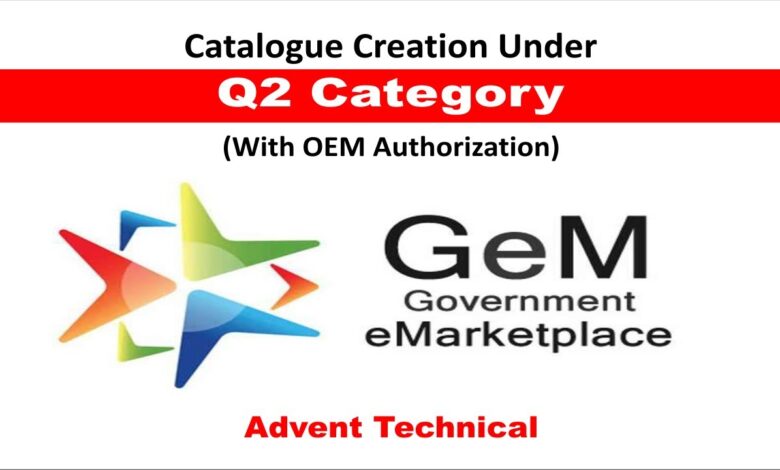WHY SHOULD BIDDERS BID ON GEM PORTAL?

Introduction: The government keeps up with technical development as the world does. The Indian government created the Government e-Marketplace (GeM), an online marketplace, to make it easier for different government departments to purchase products and services. No matter the size of the vendor, the platform enables a transparent, open, and competitive bidding process. We will go through the advantages of placing a bid on the GeM site in this post.
Access to government procurement possibilities: Bidders have a fantastic chance to access government procurement opportunities through the GeM site. All government departments and agencies must now buy their products and services through the gem portal in order to comply with the government’s mandate to enhance openness, efficiency, and cost-effectiveness in procurement. The number of chances accessible to bidders on the platform has expanded as a result of this approach.
The removal of middlemen: The GeM site gets rid of middlemen between bidders and government organisations. This makes it possible for bidders and government agencies to interact directly, which speeds up the processing of bids and lowers transaction costs. Transparency in the procurement process is also made possible by the absence of intermediaries.
Cost-effective: Bidders may compete for government procurement opportunities on a budget thanks to the GeM site. The software does away with the necessity for actual bidding and all related expenses, including travel, lodging, and printing. Additionally, bidders might cut back on expenses related to conventional bidding procedures, such as commissions paid to middlemen.
Simple registration procedure: Bidders can register quickly and easily on the GeM site. A few easy actions may be taken to finish the online registration procedure. Bidders can access a variety of procurement opportunities from several government departments and organisations after registering.
A larger market is accessible to bidders that use the gem portal to place their bids. The platform draws a lot of government departments and organisations, expanding the prospects for bidders. The platform also draws a variety of bidders, including small and medium-sized businesses, which makes the bidding process more competitive.
In conclusion, the gem portal offers bidders a great chance to take advantage of government procurement possibilities, do away with middlemen, cut expenses, and get access to a larger market. The openness and effectiveness of the procurement process will benefit bidders who sign up on the site and actively compete for government contracts.
Bidding process of gem tender
gem tenders’ bidding procedure is organised and open to the public. The procedure is set up to guarantee equity, rivalry, and effectiveness. An outline of the gem portal’s bidding procedure is provided below:
Bidders must register on the GeM site before placing a bid. Basic facts like name, address, and contact information are required throughout the online registration procedure. Bidders can view the tender papers and take part in the bidding process after registering.
Publication of Tenders: To request the products or services they need, government departments and agencies publish tenders on the GeM site. Interested bidders may download the tender materials from the portal during the bids’ open period. Bidders can also check the listings of GEM tenders on platforms like BidAssist which provides all the necessary details on gem portal listings which makes the bid more competitive.
Bidders must prepare their offers in accordance with the specifications given in the tender papers. The bid must contain all important information, including price, delivery terms, and any other pertinent data.
Submission of the Bid: After the Bid is ready, the Bidder shall submit the Bid electronically using the GeM site. Before the deadline for submitting bids, bidders are also permitted to submit revisions to their proposals.
Evaluation of Bids: The government department or agency that issued the contract appoints a committee to evaluate the bids. The price, quality, delivery conditions, and other pertinent considerations are among the criteria the committee uses to assess the bids.
Contract Award: The bidder who submitted the most competitive bid and complied with all conditions outlined in the tender papers will be given the job. Through the GeM site, the bidder is informed that the contract has been awarded.
Execution of the Contract: The selected bidder must carry out the terms and conditions outlined in the tender papers. To guarantee compliance, the government department or agency keeps an eye on how the contract is being carried out.
The gem tenders’ bidding procedure is organised and open to the public. The procedure offers bidders a fair and level playing field on which to compete for government contracting opportunities. The gem portal removes middlemen, lowers transaction costs, and maintains procurement process transparency.
Types of Tender in gem portal
Invitations to bid on contracts for products, services, or projects are known as tenders. There are several types of tenders, and each has its own unique criteria and goals. Here are some of the tenders that are most frequently used:
Open Tenders: All interested bidders who satisfy the requirements may submit an open tender. Bidders are asked to submit their offers when the tender materials are made publicly available.
Restricted Tenders: A small number of prequalified bidders may participate in restricted tenders. A pre-selected set of bidders who have been pre-qualified based on their qualifications and expertise get invitations to submit bids from the government agency or business issuing the tender.
Request for Proposal (RFP): When the project objectives are not clearly specified and a firm or government agency is looking for a solution, RFPs are employed. RFPs explain the project’s goals and encourage bidders to submit proposals outlining their strategies for tackling the work.
Requests for Quotations (RFQs) are used when a government agency or business is looking for a specific good or service and the project objectives are well stated. RFQs allow bidders to submit estimates after providing a thorough description of the requested item or service.
When project requirements are complicated and bidder input is necessary before the tender papers are finalised, two-stage tendering is employed. Proposals must be submitted in the first stage, and official bids must be submitted in the second.
Electronic Tenders: From the filing of bids through the contract award, electronic tenders are done totally online. The procedure is effective, uses less paper, and enables participation from a larger pool of bidders.
The particular needs of the project or purchase will determine the sort of tender that is employed. The most popular kind of tenders are open tenders, while other varieties, including restricted tenders, RFPs, RFQs, two-stage tendering, and electronic tenders, are also used occasionally, depending on the situation. To get all these above mentioned details about a particular bid, bidders must seek the assistance of platforms like BidAssist which provides all rounded guidance on tenders like gem tender and helps bidders win a bid in a smooth manner. Application process for GEM tenders on the government platform can be complex for most of the users. For such instances, users can take assistance from Bidassist in tender bidding on the GEM portal in a few quick steps.
CONCLUSION
In conclusion, submitting a proposal through the gem portal offers tremendous chance for bidders to engage in fair and transparent competition for government procurement opportunities. The gem portal removes middlemen, lowers transaction costs, and maintains procurement process transparency. GeM bids have an organised and open bidding procedure that prioritises efficiency, fairness, and competition. The GeM site requires bidders to register, prepare, and submit their offers there before waiting for the assessment procedure. The bidder who submits the most competitive bid and satisfies all of the conditions outlined in the tender papers will receive the contract. Depending on the particular needs of the project or procurement, GeM bids can take many different forms, including open tenders, restricted tenders, RFPs, RFQs, two-stage tendering, and electronic tenders. Overall, the GeM site encourages fair competition and offers bidders an even playing field, which ultimately serves the interests of the government and the bidders.



